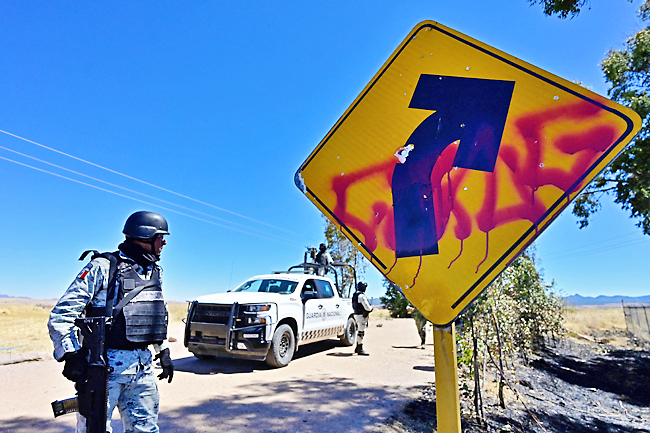ZACATECAS, MEXICO (AFP) – Escorted by heavily armed soldiers, a Mexican farmer returns to his ransacked ranch house near the front line of a war between drug cartels, whose acronyms are scrawled on bullet-pocked walls.
Recently recaptured by the security forces, Palmas Altas in the northern state of Zacatecas is now a ghost town, apart from a few well-fed dogs walking under a blazing sun.
A burnt-out pickup truck is left abandoned at the entrance to the village, which sits on an arid plateau at the foot of mountains.
Graffiti signed “CJNG” warns that the area is under the control of the Jalisco New Generation Cartel, whose leader Nemesio ‘El Mencho’ Oseguera is one of the United States’ (US) most-wanted fugitives, with a BND10 million bounty on his head.
On a nearby wall, the acronym “CJNG” has been crossed out with black paint to make way for the letters “CDS” – imprisoned drug kingpin Joaquin ‘El Chapo’ Guzman’s Sinaloa cartel.
Since 2020, the two cartels have been fighting over Palmas Altas and Zacatecas – whose main city is a colonial centre known for its Baroque-style architecture – with the state’s drug trafficking routes towards the US, as well as ports on the Pacific and Gulf of Mexico coasts.
Life in the town took a violent turn for the worse in February last year, said Miguel, a farmer in his 40s whose name AFP has changed to protect his identity.


“They started kidnapping and beating people. They killed a man and his son. Fear made us leave,” he said.
A year later, there were only five families left. Then came a chilling warning: “Either you leave or you’ll die.” The message was heard loud and clear – the village has been completely deserted since February.
Miguel took refuge in Jerez, 20 kilometres away. Thanks to the deployment of the security forces, he hopes to be able to prune his fruit trees. “Because alone, we cannot,” he said.
A total of 2,000 people have been displaced in the region, according to the authorities.
“We want them to return home,” Jerez security secretary Marco Vargas said in his office in the town, which draws tourists with its cobbled streets and ornate churches.
“We’re going to maintain the forces of order to prevent possible incursions or a return of organised crime,” he added.
That is little comfort to Nancy Reyes, whose son disappeared in mid-2021 on his way to see his fiancée.
“Nobody helps us,” Reyes said.
The teenager is one of the more than 95,000 people missing in Mexico. The uncertainty is “continuous torture” for families, said representative of a group for tracing missing persons Ricardo Bermeo Padilla.
Insecurity is nothing new for Zacatecas, which was a battleground between the Gulf Cartel and ultra-violent Los Zetas in the 2010s.
Since the Jalisco and Sinaloa cartels arrived to fight for control, violence has been a daily occurrence.
In January, 10 bodies were found in an abandoned sports utility vehicle in front of the governor’s palace in the historic centre of Zacatecas.
President Andres Manuel Lopez Obrador described the dumping of bodies in such a public place as a “provocation”.
In his red-stone cathedral with its finely carved facade, Zacatecas bishop Sigifredo Noriega Barcelo confides after the Sunday sermon that he would like to speak with “people who do evil”.
But, he added, “unfortunately, there are no interlocutors. There are many groups, which divide and subdivide”.
In the tightly secured city centre, Mexican tourists take the cable car up to a viewing point to look down on Zacatecas, whose historic heart is a UNESCO World Heritage site. There is more to Zacatecas than the cartel war, said Director of the Guadalupe Museum Rosita Franco, inviting visitors to return for a Baroque festival in September.
Even Spain’s King Felipe VI lingered while admiring the museum’s extensive 16th-19th Century library collection and its galleries during a visit in 2015 with Queen Letizia, she recalled.
Franco prefers not to talk about the violence that strikes as far as Guadalupe on the outskirts of Zacatecas city.
“We believe in the culture of peace. We believe that art changes lives and that art and culture are human rights,” she said.




